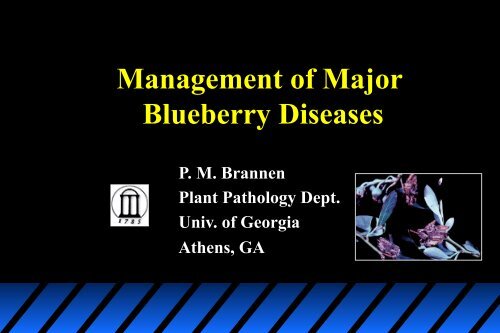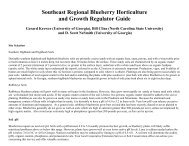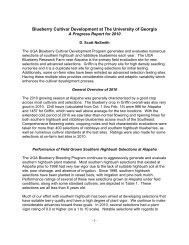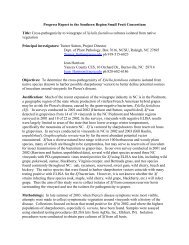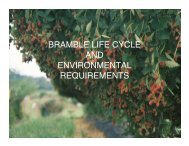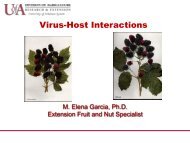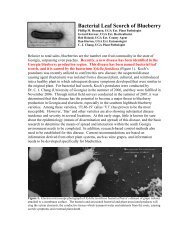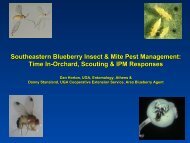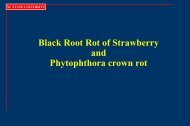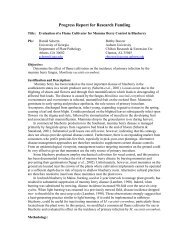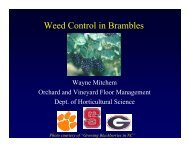Management of Major Blueberry Diseases - The Southern Region ...
Management of Major Blueberry Diseases - The Southern Region ...
Management of Major Blueberry Diseases - The Southern Region ...
- No tags were found...
You also want an ePaper? Increase the reach of your titles
YUMPU automatically turns print PDFs into web optimized ePapers that Google loves.
<strong>Management</strong> <strong>of</strong> <strong>Major</strong><strong>Blueberry</strong> <strong>Diseases</strong>P. M. BrannenPlant Pathology Dept.Univ. <strong>of</strong> GeorgiaAthens, GA
Treatment andrate/APlant health rating results*Untreated control 1.8 a**MBC-33 350 lbTelone C-35 50 galProPhyt 6 pt2.2 b2.3 b1.7 a* Rating scale: 0 = dead plant, 1 = partial death <strong>of</strong> the plant with extreme stunting, 2 =extreme leaf discoloration (reddening and yellowing) and plant stunting, 3 = moderatereddening <strong>of</strong> leaves and plant stunting, 4 = limited symptoms and very minor leafdiscoloration, 5 = healthy plant.**Analysis <strong>of</strong> covariance-adjusted means and standard errors <strong>of</strong> four replicate plots.Means within columns followed by the same letters are not significantly different by t-test comparisons (α = 0.05).
aRing nematode counts per 100 cc soil collected on 27 Jun 2008 (Alma, GA).bSubjective vigor rating recorded on 24 Sep 2008 (0 = dead . . . 5 = extremely healthy).cRing nematode counts per 100 cc soil collected on 1 Aug 2008 (Homerville, GA).dMeans followed by the same letters are not significantly different according to Fishers protected LSD test.TreatmentsTrial LocationAlapaha, GANematodeCounts aVigorRatingbHomerville,GANematodeCounts c(1) Untreated control (bare ground) 26.8 ab d 2.2 b 558.0 a(2) Untreated control (plastic only) 41.0 a 2.9 a 622.5 a(3) PicChlor 60 (60% chloropicrin and 40%Telone) @ 21 gallon/acre broadcast rate3.0 c 3.3 a 37.5 b(4) Telone II @ 7 gallons/acre broadcast rate 10.0 bc 3.1 a 441.0 a(5) Methyl bromide 50:50 (50% MeBr and50% chloropicrin) @ 350 lb/acre broadcast rate0.0 c 3.4 a 1.0 bLSD (α = 0.05) 18.3 0.6 250.4
Where does lime sulfur fit or does it fit?v Bottom line – we do not know for sure.v Lime sulfur will need to be applied in the dormant orlate dormant stage in GA (probably a December –late January application, depending on blueberryvariety and species); high temperatures (above 75 F)will increase burn to buds, leaves, blooms, etc.v It is a clean up material, and it is generally thoughtto reduce inoculum – killing overwintering fungi.v Limited data is available, and it would be prematureto recommend the use. However, if used, it maypossibly help to prevent some dieback diseases (notmummy berry as some labels indicate).
Mummy Berryv GA blueberries are primarily rabbiteyecultivars, Vaccinium ashei (>90% <strong>of</strong>acreage).v Mummy berry disease§ Causal agent: Monilinia vaccinii-corymbosi§ Losses: yield reduction, cost <strong>of</strong> control,and lower quality grades post-harvest
SummerLate WinterSummer Spring Spring
Indar, Orbit, or TiltandPristine
Indar and RotsTreatment and rate/A(applied at late green tip,full bloom and blossomdrop)Fruit rot(% incidence <strong>of</strong>C. acutatum)TRIAL 1Fruit rot(% incidence <strong>of</strong>C. acutatum)TRIAL 2Unsprayed Check 30.0 a 48.5 aIndar 75WP 2.0 oz 49.0 b 73.5 bA.M.C. Schilder et al., Michigan State University; 1999 and 2000
Ripe Rot Trial ResultsTreatment and Rate/Acre (appliedat pink bud, early bloom andfull bloom)Fruit rot(% incidence<strong>of</strong>C. acutatum)Fruit rot(% incidence<strong>of</strong>C. acutatum)Fruit rot(% incidence<strong>of</strong>C. acutatum)Harvest 1Harvest 2Harvest 3Unsprayed Check 38.7 a 23.0 a 11.5 aBenlate 50WP 1.0 lb + Captan75WG 3.0 lbIndar 75WP 2.0 oz + Latron B-19568.0 fl oz + Captan 75WG 3.0 lb4.5 b 2.0 d 2.3 b9.0 b 6.2 d 9.8 aIndar 75WP 2.0 oz 22.4 ab 12.3 c 6.8 abIndar 75WP 2.0 oz + Latron B-19568.0 fl oz38.6 a 18.4 ab 12.1aP=0.05 W.O. Cline and B.K. Bloodworth, NC State; 1999
Captan actually does a lot for us, andit should probably be applied withIndar, since there is pretty strongevidence that Indar alone mayincrease rots – may be moreproblematic in southern highbushvarieties.
Effect <strong>of</strong> fungicide treatments on the incidence <strong>of</strong> primary and secondary infection byMonilinia vaccinii-corymbosi on ‘Brightwell’ rabbiteye blueberry in Alma, GA (2003).Treatment Rate/A Avg. number <strong>of</strong>strikes per bushAvg. number <strong>of</strong>mummies per m 2Untreated control --- 50.3 ± 8.3 a 10.7 ± 0.31 aAbound 12.4 fl oz 30.2 ± 8.4 ab 8.9 ± 0.31 abcCaptEvate 5.25 lb 44.6 ± 8.5 ab 9.7 ± 0.32 abIndar 2 oz 5.3 ± 8.3 c 3.7 ± 0.31 cdOmega 12 fl oz 22.3 ± 8.3 bc 6.1 ± 0.31 abcdOrbit 6 fl oz 6.2 ± 8.5 c 4.3 ± 0.32 bcdPristine 20 oz 8.4 ± 8.4 c 3.1 ± 0.32 dScala 18 fl oz 38.9 ± 8.3 ab 11.4 ± 0.31 aTopsin-M + Captan 1 lb + 5 lb 41.1 ± 8.3 ab 8.5 ± 0.31 abcApplications were made on 28 February (pre-bloom), 8 March (1% bloom), and 14 March(20% bloom) via airblast sprayer in 50 gal/acre water.Stanaland, Brannen, and Scherm; 2003
Botrytis Blossom Blight
Botrytis Blight and Fruit Rot(Botrytis cinerea)v Problem in prolonged cool, wet conditions.v Losses are due to blossom blight and fruitrot, as well as reduced fruit buds for the nextyear.v Frost or cold damage during bloom, as wellas poor pollination, encourages the disease,but this is not necessary for infection. Cool,wet conditions are all that is required. <strong>The</strong>blighted blooms will cause twig blight.
Botrytis Blight and Fruit Rot(Botrytis cinerea)v Monitor during bloom. Many producersalways apply fungicides for Botrytis.v Apply fungicidal sprays, if conditionswarrant, during bloom.v Maintain adequate air flow, and do notoverfertilize with nitrogen fertilizers inthe spring (creating succulent growth).
OverwinteringBotrytisSclerotiaAPS Press; <strong>Diseases</strong> <strong>of</strong> Small Fruits
APS Press; <strong>Diseases</strong> <strong>of</strong> Small Fruits
Young leaves are infected through contact withblossoms.APS Press; <strong>Diseases</strong> <strong>of</strong> Small Fruits
APS Press; <strong>Diseases</strong> <strong>of</strong> Small FruitsDeveloping berries can become infected, but thesymptoms do not show up till after harvest.
Switch, Elevate,CaptEvate, Pristine, andCaptan are registeredfor control <strong>of</strong> Botrytisblossom blight.
Primary <strong>Blueberry</strong> Rotsv Anthracnose (Ripe) Rot(Colletotrichum acutatum andColletotrichum gloeosporiodes)v Alternaria Fruit Rot (Alternariatenuissima)
Anthracnose (Ripe) Rot
Alternaria Fruit RotAPS Press; <strong>Diseases</strong> <strong>of</strong> Small Fruits
Alternaria Fruit RotAlternaria spp., fungi. Although not ascommon as ripe rot, this disease has causedsevere losses in some Oregon fields.Infections can occur any time between latebloom through fruit maturity. Infections remainquiescent (latent) until fruit ripens. <strong>The</strong>disease <strong>of</strong>ten is not seen in the field butdevelops in storage or in transit to market.Oregon State University
Alternaria Fruit RotIn post-harvest experiments, 96% <strong>of</strong>alternaria rot infections occurredthrough the stem scar <strong>of</strong> the berry. Thisindicates that most alternaria infectionsare not initiated until after fruit isharvested, because the stem scar isonly exposed when berries aredetached.Bill Cline; North Carolina State University
Post-Harvest Cooling and RotsPostharvest Cooling has given the most consistentcontrol <strong>of</strong> postharvest decay. Cooling the fruit afterharvest retains quality and prolongs shelf life. Cool asquickly as possible to 40° F (5° C) or lower, but notbelow 32°F (0° C). If cooled promptly and kept cool,quality blueberries packaged ready for retail sale canbe expected to hold up well at 32° F (0° C) for 2weeks and at 40° F (5° C) for 1 week, but only for 2days at 70° F (21° C). Forced-air cooling is the mostsatisfactory method for quickly reducing thetemperature <strong>of</strong> palletized blueberry fruit in consumerreadycontainers.Bill Cline; North Carolina State University
Rot Controlv Fungicide sprays (Switch,Abound, Cabrio, Pristine , andCaptan) and rapid coolingimmediately following harvestprovide for control.v Infection can take place at any timeon the fruit, but critical times appearto be bloom, post-bloom andpreharvest.
Primary <strong>Blueberry</strong> Leaf Spotsin Georgiav Septoria Leaf Spot (Septoria albopunctata)v Anthracnose Leaf Spot (Gloeosporium minus)v Leaf rust (Pucciniastrum vaccinii)v Pestalotia (Pestalotia sp.)v Phyllosticta (Phyllosticta sp.)v Powdery Mildew (Microsphaera vaccinii)v Non-pathogenic or Physiological Leaf Spots
Septoria Leaf Spotv Generally mostsevere on olderleaves which areclose to the ground.v Very serious damagein rooting beds.v Small spots; white totan center and purpleborder.J. R. Meyer and W. O. Cline; <strong>Blueberry</strong> Pest<strong>Management</strong>, a Seasonal Overview; 1997
Anthracnose Leaf Spotv Caused byGloeosporiumminus.v Causes large,irregular-shaped,brown lesions witha red border.v Lesions <strong>of</strong>ten startat the edge <strong>of</strong> theleaf.J. R. Meyer and W. O. Cline; <strong>Blueberry</strong> Pest<strong>Management</strong>, a Seasonal Overview; 1997
Anthracnose Leaf SpotAnthracnose(large spot)Bill Cline; North Carolina StateSeptoria(small spot)Bill Cline; North Carolina StateAPS Press; <strong>Diseases</strong> <strong>of</strong> Small Fruits
Anthracnose Leaf Spot(Second Type)v Different organism(s);Colletotrichumgloeosporioides and C.acutatum.v Also causes anthracnoseripe rot <strong>of</strong> fruit.v Reported as a seriousproblem in Georgiaduring warm, wetconditions.v Lesions are brown.APS Press; <strong>Diseases</strong> <strong>of</strong> Small Fruits
Leaf Rustv Oblong to angular leafspots first develop onthe upper leaf surface.v Pale green to yellowand then maroon tobrown in color.v Lower leaf maydevelop salmon-toorangepustules.
APS Press; <strong>Diseases</strong> <strong>of</strong> Small FruitsLeaf Rust
Pustules on underside <strong>of</strong> leaf.Urediospores
Non-PathogenicLeaf Spotsv Most common <strong>of</strong> all in 2002!Very common in 2003 as wellv Found on most rabbiteye samplesv Symptoms:v Leaf fleckingv Water-soakingv Edema-like blotchesv Mechanical, hypersensitiveresponse, insect and/orphysiological damage?
2002 Leaf Spot Susceptibility RatingCultivar Septoria Anthracnose RustBrightwell ++++ ++ ++Climax ++ ++ +++Powderblue +++ ++ +++Premiere +++ ++ ----Tifblue +++ ++ ----ONeal ---- +++ ----Star +++++ +++ ----
2003 Leaf Spot Susceptibility RatingCultivar Septoria Anthracnose RustBrightwell ++++ +++ +Climax ++ +++ +++Powderblue +++ +++ ++Premiere +++ +++ +Tifblue +++ ++ ----Blue Crisp +++ ++ +++Star +++++ +++ ++
Leaf Spot Field Trial Yield ResultsTreatment and Rate/AcreYield Increase(% over UTC)Yield Increase(% over UTC)Untreated Control (UTC) 0 0Benlate 50WP 1.0 lb + Captan 75DF 3.0 lb 37 26Indar 75WP 2.0 oz 44 34Indar 75WP 2.0 oz + 0.125% B-1956 48 32P=0.05Bill Cline; North Carolina State
Disease severityWhat are the effects <strong>of</strong> leaf spot severityon subsequent flower bud set and yield?DefoliationFlower bud number vs. leaf spot severity16ReturnbloomPeter OjiamboNumber <strong>of</strong> flower buds per shoot1412108642Potentialyield gapYield00 50 100 150 200 250Disease severity (average number <strong>of</strong> spots per leaf)Premier, UGA, 2001
Negative physiological effects due to leafspots may occur well before leavesdefoliate.14Assimilation rate ( µ mol CO 2m -2 s -1 )1210864200 10 20 30 40 50 60Disease severity (% leaf area affected)Bluecrisp, Homerville, 2002Inga Rol<strong>of</strong>f
SummaryTotal fruit weight (g per shoot)Fruit yield vs. leaf spot severity8060402000 50 100 150 200 250Disease severity (average number <strong>of</strong> spots per leaf)Premier, UGA, 2001v Leaf spots reducephotosynthesis andinduce prematuredefoliation.v Both reduce flower budset in the fall and yieldthe next spring.v Leaf spot control neededfor optimal yields onsusceptible cultivars.v Need to develop leafspot thresholds fortreatment.
14Premiere Data12Bluecrisp DataFlower Bud Number12108642Flower Bud Number10864202400120Spots per LeafSpots per Leaf
<strong>Southern</strong> Highbush <strong>Blueberry</strong> Defoliation Trial Results1998 Yield(Fruit Fresh Wt. [g/cm shoot])1999 Yield(Fruit Fresh Wt. [g/cm shoot])Defoliation DateMisty Sharpblue Misty SharpblueSeptember 0.26 b 0.18 b 0.22 d 0.11 cOctober 0.23 b 0.24 b 0.87 c 0.59 bNovember 0.75 b 0.67 a 1.70 b 0.81 abDecember 1.45 a 0.95 a 1.89 b 1.09 aControl (nomechanicaldefoliation)P=0.051.50 a 0.67 a 2.60 a 0.82 abWilliamson and Miller; University <strong>of</strong> Florida
Effect <strong>of</strong> increasing sequential applications <strong>of</strong> Abound on severity andincidence <strong>of</strong> Septoria leaf spot and subsequent defoliation (2003).TreatmentDisease Severity*(1 Oct)Disease Incidence(1 Oct)Defoliation(18 Nov)1. Untreated Control 48.6 a 99.6 a 100.0 a2. Abound (1 app.) 27.2 b 95.6 a 83.3 abc3. Abound (2 apps.) 11.4 bc 88.0 abc 93.3 ab4. Abound (3 apps.) 20.2 bc 92.8 ab 79.7 abc5. Abound (4 apps.) 7.4 bc 82.4 bc 63.9 abc6. Abound (5 apps.) 5.7 c 76.8 c 59.2 bc7. Abound (6 apps.) 6.8 c 79.2 c 51.2 cLSD (P=0.05) 20.3 12.7 39.2*Means followed by the same letters are not significantly different according toFishers protected LSD test.
Georgia currently has 24C state labels for use <strong>of</strong>Bravo Ultrex and Bravo WeatherStik for control <strong>of</strong>both rust and Septoria leaf spots; these chlorothalonilproducts make excellent rotation partners for thestrobilurin-containing products, Cabrio and Pristine.However, Bravo Ultrex or Bravo WeatherStik canonly be used after harvest, as fruit damage occurswith chlorothalonil usage. For labels andrecommended rates for Georgia, contact your localcounty agent (for internet connections, click on theselinks – BRAVO ULTREX; BRAVO WEATERSTIK).
Comparison <strong>of</strong> Cabrio and Phosphonate forControl <strong>of</strong> Septoria Leaf Spot <strong>of</strong> <strong>Blueberry</strong>% Leaf Area Infected6543210Phosphonate Cabrio UntreatedSeptoria disease severity following treatment with Cabrio andphosphonate, as compared to an untreated control.
Aluminum tris (O-ethyl phosphonate)http://www.agrimor.com/aliette.htm
For some fungi, the mode-<strong>of</strong>-action for Aliette isthought to be induced systemic resistance. For theoomycetes (not true fungi; algae-like), Aliette mayhave a direct toxic effect. Aliette containsaluminum tris-O-ethyl phosphonate, <strong>of</strong> which thephosphonate moiety may be critical to activity.Some literature indicates that phosphitematerials would logically have better efficacythan phosphate materials.
Phosphonatesv Target site is still listed as unknown(FRAC).v Fosetyl-Al (Aliette) is a primary wellknownfungicide in this class, butphosphorous acid is the primary endproduct which is thought to be active.
2004 Leaf Spot Trial ResultsPotassiumphosphiteSeptoria leaf Dipotassium spot Anthracnose phosphateFungicide and rate/A Incidence Severity Incidence Severity Defoliation1) Untreated Check 26.8 a 1.3 a 66.4 a 21.9 a 60.0 a2) Aliette 5 lb 0.0 b 0.0 b 11.6 c 2.0 bc 10.4 b3) ProPhyt 4 pt 0.4 b 0.0 b 12.0 c 1.1 c 12.4 bc4) Biophos 4 pt 0.4 b 0.0 b 22.4 b 3.9 b 22.0 b5) Cabrio 20EG 14 oz 0.0 b 0.0 b 8.0 c 0.5 c 10.8 c6) Cabrio 20EG 14 ozalternated with ProPhyt4 pt (2 applicationseach)0.0 b 0.0 b 13.2 c 1.1 c 11.6 bc7) Manzate 75DF 3 lb 1.2 b 0.0 b 9.2 c 0.1 c 13.0 bcLSD (P = 0.05) 7.8 0.4 8.2 2.2 10.9Application dates were 12 Jun, 28 Jun, 12 Jul, and 27 Jul.Dipotassium phosphonate +
Fungicide and rate/A2005 Leaf Spot Trial ResultsPotassiumphosphitesSeptoria leaf spotSeverity(Clinch)Severity(Bacon)AnthracnoseIncidence(Bacon)Severity(Bacon)Defoliation(Bacon)1) Untreated Check 16.4 a 3.3 a 67.6 a 20.5 a 43.0 a2) Aliette 5 lb 5.3 b 0.1 b 22.8 b 2.3 b 15.2 b3) ProPhyt 4 pt 7.7 b 0.2 b 20.0 bc 2.7 b 10.0 b4) Agri-Fos 5 pt 3.0 b 0.2 b 18.0 bc 1.7 b 12.0 b5) Cabrio 20EG 14 oz 5.5 b 0.2 b 7.6 d 0.4 b 8.8 b6) Cabrio 20EG 14 ozalternated with ProPhyt 4pt (2 applications each)5.5 b 0.1 b 10.4 cd 1.0 b 4.2 b7) Procure 480SC 16 fl oz 8.2 b 0.8 b 13.2 bcd 1.0 b 13.8 bLSD (P = 0.05) 5.9 1.5 9.7 2.7 15.0
Other Potential Rust Controlsv Various sulfur formulationsv Cupric Hydroxide (postharvest)
Phytophthora Root Rot(Phytophthora cinnamomi)v <strong>Major</strong> problem in <strong>Southern</strong> highbush; canbe a problem in rabbiteye as well.v Drainage is critical.v Aliette (Fosetyl-Al) and Ridomil Gold(Metalaxyl/Mefanoxam) are registered forcontrol.v Neither product is very effective atcleaning up infected plants.v Pythium species can also be an issue inwet conditions.
Phytophthora cinnamomiSmooth oogonium <strong>of</strong> PhytophthoracinnamomiZentmeyer, G.D. 1980. Phytophthoracinnamomi and the <strong>Diseases</strong> it Causes.APS.CABI Compendia
Pythium irregulareOogonium <strong>of</strong> Pythium irregulare withirregular wall projecton and diclinousantheridium. A.E. Dorrance et al., PlantHealth Progress, Jan 2004.
Phytophthora Root Rot(Phytophthora cinnamomi)v <strong>Major</strong> problem in <strong>Southern</strong> highbush; canbe a problem in rabbiteye as well.v Drainage is critical.v Aliette (Fosetyl-Al) and Ridomil Gold(Mefanoxam) are registered for control.v Neither product is very effective atcleaning up infected plants.v Pythium species can also be an issue inwet conditions.
APS Press; <strong>Diseases</strong> <strong>of</strong> Small Fruits
If the phosphonate materials showroot-rot control activity which issimilar to Aliette, then we may beable to cheaply apply thesematerials – also obtaining leaf spotcontrol and possibly control <strong>of</strong>other pathogens.
Experimental Phosphonatesv ProPhyt (potassium phosphite 54.5%;phosphorous acid equivalent 34.3% [4.2 lb/gallon])v AgriFos (mono- and di-potassium salts <strong>of</strong>phosphorous acid [5.17 lb/gallon]equivalent to 3.35 lb phosphorous acid pergallon)
2005 Phytophthora Root Rot Trialv Randomized complete block designv Four replications (five plants per plot)v Transplanted Millenium on 15 Mar 05 in previouslyplanted barkv ProPhyt and Aliette were applied as foliar applicationsto run<strong>of</strong>f, while Ridomil Gold EC was drench applied.Application dates were 11 Apr, 11 May, 20 Jun, and21 Julv Root rot severity was assessed on 7 Sep 05; budcount and plant fresh weight (no leaves) data wereassessed on 28 Feb 06.
2005 Root Rot ResultsFungicide and rate/ARoot RotSeverity*Plant Wt. (g)Bud Count1) Untreated Check 2.2 b 236 c 70.3 c2) Ridomil Gold EC 0.4 gal 3.6 a 912 ab 351.9 b3) Aliette 5 lb 3.9 a 1104 a 456.9 a4) ProPhyt 4 pt 3.7 a 860 b 422.3 abLSD (P = 0.05) 0.4 210 70.5*Rating scale (0 = dead plant, 1 = partial death <strong>of</strong> plant with extreme stunting, 2= extreme leaf discoloration (reddening and yellowing) and plant stunting, 3 =moderate reddening <strong>of</strong> leaves and plant stunting, 4 = limited symptoms and veryminor plant discoloration, 5 = healthy plant)
Brannen, P.M., and S. NeSmith. 2006. F&N Tests Reports 60:SMF016
2006 Phytophthora Root Rot Trialv Randomized complete block designv Four replications (three plants per plot in Alapaha and four plantsper plot in Griffin)v Transplanted <strong>Southern</strong> Bell during week <strong>of</strong> 13 Mar 06 inpreviously planted bark beds and new bark beds (two separateexperiments at two locations [Griffin and Alapaha, GA)v Cabrio, ProPhyt, and AgriFos were applied as foliar applicationsto run<strong>of</strong>f, while Ridomil Gold EC was drench applied. Applicationdates were 10 Apr, 8 May, 4 Sep, and 16 Oct in Alapaha, GA.Application dates were 10 Apr, 8 May, 4 Sep, and 9 Oct in Griffin,GA.v Root rot severity was assessed on 10 Nov (Griffin) and 14 Nov(Alaphaha); bud count data were assessed on 13 Feb 07 (bothGriffin and Alapaha).
2006 Results* Griffin, GA Alapaha, GAFungicide and rate/A Old Bark New Bark Old Bark New Bark1) Untreated Check 3.1 bc 3.1 a 0.7 d 0.4 c2) Cabrio 20 EG 14 oz 2.8 c 3.1 a 0.6 d 1.4 bc3) Ridomil Gold EC 0.4 gal 3.7 ab 3.5 a 1.7 c 2.7 ab4) ProPhyt 4 pt 4.2 a 3.3 a 2.5 a 3.6 a5) AgriFos 5 pt 4.3 a 3.3 a 2.3 ab 3.5 a6) Ridomil/ProPhyt Rotation 3.8 ab 3.3 a 2.0 bc 3.0 a7) Ridomil/AgriFos Rotation 4.0 a 3.5 a 2.0 bc 3.1 a*Rating scale (0 = dead plant, 1 = partial death <strong>of</strong> plant with extreme stunting, 2 = extremeleaf discoloration (reddening and yellowing) and plant stunting, 3 = moderate reddening <strong>of</strong>leaves and plant stunting, 4 = limited symptoms and very minor plant discoloration, 5 =healthy plant)
2006 Results* Griffin, GA Alapaha, GAFungicide and rate/A Old Bark New Bark Old Bark New Bark1) Untreated Check 214.6 ab 240.0 a 12.0 cd 12.0 bc2) Cabrio 20 EG 14 oz 135.6 b 188.5 a 5.5 d 11.0 c3) Ridomil Gold EC 0.4 gal 223.4 ab 209.9 a 45.8 ab 82.3 abc4) ProPhyt 4 pt 290.9 a 201.5 a 64.0 a 104.8 a5) AgriFos 5 pt 310.4 a 244.8 a 36.3 bc 84.3 abc6) Ridomil/ProPhyt Rotation 256.1 a 203.1 a 53.5 ab 85.5 ab7) Ridomil/AgriFos Rotation 256.5 a 220.3 a 48.8 ab 85.5 ab*Average number <strong>of</strong> flower buds per plant. P = 0.05
ConclusionsIn addition to Aluminum tris (O-ethyl phosphonate)(Aliette), other phosponates work equally well forsuppression <strong>of</strong> Phytopthora root rot <strong>of</strong> blueberry.Phosphonates also provide equivalent control to that<strong>of</strong> mefenoxam (Ridomil Gold). <strong>The</strong> cost <strong>of</strong>phosphonates and ease <strong>of</strong> application, bycomparison to other root rot fungicides, will makethem an attractive alternative in blueberryproduction.
APS Press; <strong>Diseases</strong> <strong>of</strong> Small Fruits
Tissue Analysis ResultsCalcium CopperManganese BoronSampleResults2.8% 0.08 ppm 4309 ppm 227ppmSufficiencyRanges0.35-0.80%6 – 11 ppm 40 – 600ppm25 –75ppm
Lessons Learnedv Fertility levels are important.v Tissue and bark analysis will benecessary, especially for high bushblueberry production where bark systemsare utilized.v Water analysis is also important.
Glyphosate InjuryAPS Press; <strong>Diseases</strong> <strong>of</strong> Small Fruits
Necrotic Ringspot VirusAPS Press; <strong>Diseases</strong> <strong>of</strong> Small Fruits


